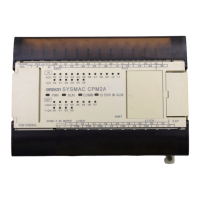1-4SectionFunctions Listed by Usage
19
Usage Refer
to
Function
Multiply the input pulse frequency from a high-speed counter by a fixed
multiple, convert that value to an analog value, and output as an
analog output.
(For example, synchronizing the speed of a supply conveyor with the
rotational position of the main piece of equipment (such as a label
inserter) measured by an analog input.)
Pulse synchronization and analog
output function
W353
Reliably receive input pulses with an ON-time shorter than the cycle
time (such as inputs from a photomicrosensor).
Quick-response input function
Interrupt functions
Execute a special process very quickly
when an input goes ON.
(For example, operating a cutter when an
interrupt input is received from a Proximity
Switch or Photoelectric Switch.)
Interrupt input (interrupt input mode)
Count input ON pulses and execute a
special process very quickly when the
count reaches the preset value.
(For example, stopping the supply feed
when a preset number of workpieces have
passed through the system.)
Interrupt input (counter mode)
Execute a special process at a preset
count value.
(For example, cutting material very
precisely at a given length.)
High-speed counter interrupt
generated when the count matches
the set value.
Execute a special process when the count
is within a preset range.
(For example, sorting material very quickly
when it is within a given length range.)
High-speed counter interrupt
generated when the count is within the
set range.
Execute a special process when a timer
times out.
(For example, stopping a conveyor at very
precise time (independent of the cycle
time) after the workpiece is detected.)
Interval timer interrupt
(One-shot mode)
Repeat a special process at regular
intervals.
(For example, the speed of a sheet feeder
can be monitored by measuring the input
signal from an encoder at regular intervals
and calculating the speed.)
Interval timer interrupt
(Scheduled interrupt mode)
Perform simple positioning by outputting pulses to a motor driver that
accepts pulse-train inputs.
Pulse output function
Use a variable duty-ratio output to perform time-allocated temperature
control.
Analog input + Variable duty-ratio
output pulse function (PWM(––))
Easily set and fine-tune settings such as the low-speed feed rate when
a conveyor is temporarily stopped.
Analog controls
Receive an analog input and output an analog output. Analog I/O Unit
(Connect the Analog I/O Unit to the
CPU Unit.)
Receive temperature sensor input directly at the PC. Temperature Sensor Unit
(Connect the Temperature Sensor
Unit to the CPU Unit.)
Reduce required wiring, space, and PC load by controlling equipment
with a few low-capacity PCs dispersed near the equipment rather than
a single, large, centralized PC.
(Create a remote I/O link with a CompoBus/S Master and CompoBus/S
Slaves.)
CompoBus/S I/O Link Unit
(Connect the CompoBus/S I/O Link
Unit to the CPU Unit.)

